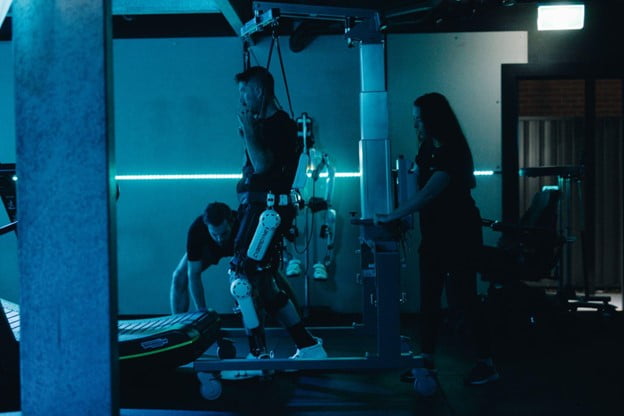Innovation In The Sector: A discussion with the team from RoboFit
For many participants, improving mobility and balance are core goals. Now with promising technology, some of those with limited movement are beginning to make huge strides forwards.
In an Australian first, provider RoboFit uses a neuro-controlled exoskeleton to help participants to improve their mobility, posture, balance and lower limb strength.
RoboFit’s mission is to empower people to redefine what’s possible. We spoke to the team to learn more about the difference they’re making in participants’ lives.
What does RoboFit do?
Located in NSW, RoboFit is an exercise and physical therapy clinic specialising in a range of services. They assist those living with neurological or musculoskeletal conditions including:
- Spinal cord injury
- Brain injury
- Parkinson’s disease
- Multiple sclerosis
- Cerebral Palsy
- Stroke
Our unique approach is about helping participants to reach their goals and improve their quality of life.
How does RobotFit work?
RoboFit’s team is made up of exercise physiologists and physiotherapists who work with clients in goal-based sessions or using the assistance of ‘HAL’ the world’s first neuro-controlled exoskeleton. HAL helps to train, support and enhance the wearer’s strength.
HAL operates using electrodes, HAL reads the wearer’s bioelectric signals, interprets their intention, and then works with them to complete movements. The wearer, for example, may be able to provide 30% of the effort required for a movement––HAL can then provide the remaining 70%. Doing these movements helps remap the wearer’s neural pathways to improve mobility and movement over time.
Not all exoskeletons are created equal, HAL is unique as it combines the ability to work with clients with a range of functional ability from complete injuries, to clients who are wanting to focus on their walking technique. The device can assist and progress with clients as they work towards achieving their goals.
RoboFit’s team uses assistive technology including:
- Lower limb HAL exoskeleton: assisting with gait training, posture, balance, sit-to-stand, trunk and core control.
- Single joint HAL exoskeleton: providing targeted support to the ankle, knee, elbow or wrist.
- Lumbar support exoskeleton: progression for clients transitioning out of the lower limb type HAL, as well as a fall prevention, posture, seated reach and balance tool.
How does RobotFit help?
At RoboFit, we offer a range of health, rehabilitation and wellbeing services, delivered at our centre and in the home by our experienced allied health team.
Our services are personalised for participants’ health and wellbeing goals, and use a blended approach of cutting-edge technology and traditional exercise physiology to maximise results.
Our services can help participants to improve their quality of life in a range of areas including:
- Walking speed and endurance
- Balance
- Posture
- Lower limb strength
- Bone density
- Blood flow
- Mental health
- Improved bladder and bowel function
What are the results of RoboFit?
The results are extremely promising. Take participant Dan, for example. Over a 4 week block period, Dan’s 6-minute walking test distance doubled from 75m to 150m with assistance,
and increased by a further 20% in week eight to 180 metres.
Another participant, Tracy, was surprised by how much the experience benefited her.
“I was amazed after the first HAL session, just watching the fluid walking motion of myself. I didn’t think I’d be able to do it, but I did,” she said.
And Jimmy noticed significant improvements too. “I think RoboFit is probably the best gait training I’ve seen, and I’ve seen it all, believe me! I think if you suffer an issue with some form of walking or gait issue, you need RoboFit,” he said.
What are the costs?
For NDIS participants, RoboFit may be funded as part of your plan––assuming it aligns with your goals, or you receive a letter of support from an occupational therapist. As with all supports, anything that’s funded must be considered ‘reasonable and necessary’ by the NDIS.
Exercise physiologist and physiotherapist sessions are in line with the NDIS price guide.
HAL sessions are generally 2 hours, though some clients opt for a 90-minute session to manage fatigue. The costs cover an Exercise Physiologist and the hire of the assistive technology HAL Exoskeleton.
Sessions are $250 per hour or $375 for a 90-minute session.
If a participant is travelling interstate, it’s also helpful to keep in mind that Short Term Accommodation (STA), may be funded under your plan.
How can people get in touch?
We’re only too happy to answer questions. Get in touch via phone 1800 560 842 or via our online contact form.
RoboFit currently has two clinics:
- Unit 2-3, 19-21 Ralph Black Drive North Wollongong NSW 2500
- 576-578 Botany Road, Alexandria NSW 2015
- Additional clinics are opening in the near future, contact our team to be put on the waitlist.
>
Or, if you’re ready to dive in, get started with RoboFit through these steps:
- Download our brochure
- Fill in the RoboFit Booking Form online
- Complete your Medical Clearance form
- Email forms to [email protected]
We’re here to help
At myAutonomy, we want all of our participants to thrive. If you need help making the most of your funding, reach out.
Contact us at 1300 60 33 89 or at [email protected] and we can assist.





